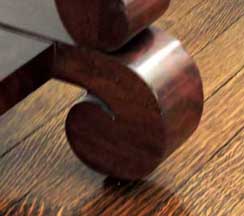Chairs - CONSTRUCTION Illustrated FURNITURE Glossary .......... Illustrated Architecture Dictionary
Furniture - Legs / Feet / Stretchers
Table of Contents:
| Animal legs | |
| Bandy-legged A colonial American term for bowlegged or cabriole-legged furniture of the England and America in the early 18th century. |
|
|
|
Cabriole
(KAB
ree ole) leg
A
curved leg with outcurved knee and incurved ankle. Used on many types of furniture besides chairs.
|
|
|
Knee
|
| Lyre-shaped
legs Popular during the Empire period. |
|
|
|
Marlborough
leg Block foot:
Another name for the Marlborough foot
|
|
|
|
|
|
Spiral
leg
|
|
|
Saber
legs
|
|
|
Square
leg Hepplewhite Pembroke table - American Antique Furniture, Orchard Park, NY |
|
|
Tapered
leg Leg narrows from top to bottom. Found on Hepplewhite pieces. A raised, tapered design superimposed on the existing leg is referred to as the "spade" foot. Illustration: Hepplewhite Pembroke table - American Antique Furniture, Orchard Park, NY |
|
|
Arrow
foot
|
|
|
Ball
foot Similar to a bun
foot, but rounder.
|
|
|
Block
foot See Marlborough leg above |
|
|
|
|
|
Bracket
foot One of the
simplest of furniture feet shaped like a bracket, usually
with a mitered corner. See French foot below Commonly found in Hepplewhite and Sheraton designs
|
|
|
Bun
foot
|
|
|
Carved to represent a bird's claw grasping a ball Derived from the Chinese dragon's claw holding a crystal ball or jewel. Perhaps first adapted in Europe by the Dutch, it spread to England, from whence it was introduced to America about 1735. Enormously popular as the foot of American cabriole leg furniture in the Queen Anne and Chippendale, styles. In America, a bird's claw was generally used, mostly the eagle's. Also used in the twentieth century in the Colonial Revival cabriole leg.
|
|
|
Club
foot
/ pad foot
|

|
C-scroll Found especially in Empire style
|
|
|
|
|
|
|
| Drake
foot See "Trifid foot" |
|
| Dutch
foot See "pad foot" below |
|
|
|
Elongated
bulb feet Sometimes found on Sheraton style tables |
|
|
|
|
|
French
(bracket)
foot
|
|
|
|
|
|
|
|
|
Marlborough
foot See Marlborough leg above |
|
|
Monopodium
|
|
|
An onion-shaped turned foot of the Early Renaissance not very much used after the William and Mary Period.
|
|
|
Alternate
names: Dutch foot, club foot Sometimes a club
foot resting on a disk is termed pad foot.
|
|
|
Paw
foot "Greek tripod tables (usually used for serving wine) had legs carved into animal leg and paw foot designs modified from ancient Egyptian prototypes with the introduction of duck heads and acanthus leaves." - Treena Crochet, Designer's Guide to Furniture Styles," pub. 2204, p. 47
|
|
|
|
|
|
Scroll
foot / Scrolled toe / Whorl foot See Whorl foot below See C-scroll foot above |

|
Slipper
foot A club foot with a more pointed and protruding toe. Popular in Queen Anne period.
|
|
|
Foot carved to look like snake's head. Narrow elongated foot swelling slightly upward before pointed end.
|
|
|
Tapered rectangular foot Popularized by Thomas Chippendale. Commonly found in Hepplewhite and Sheraton designs. Formed by applying pieces of wood - not by carving.
|
|
|
Also called:
Spanish scroll foot or Braganza toe A hoof-like, grooved and flared foot which ends in an inward curving scroll Introduced from Portugal during the Restoration period and used in 18th-century English and American furniture, especially on turned legs in the William and Mary and the Queen Anne periods
|
|
|
Splay
foot Same as flared foot above. |
|
|
Trifid
(TRY
fid) foot 3-lobed endpiece of a Queen Anne cabriole leg. Derived from Irish furniture design.
|
| Turnip
foot A ball foot with a small collar at the base |
|
|
|
Whorl
foot
/ scrolled toe / scroll foot Many of the
drawings in Thomas Chippendale's Gentleman and Cabinet
Maker's Director in 1754 feature whorl feet.
|
|
|
Stretcher Egyptian craftsworkers reinforced the joinery by adding stretchers, continuous stretchers, or runners to the legs of stools and chairs. Occasionally, struts were also added between the stretcher and seat rail for extra stability and strength.
|
|
|
Box
stretcher
|
|
|
Cross
stretcher See X-stretcher below |
|
|
H
stretcher
|
|
|
X
stretcher Domed cross stretcher
|
